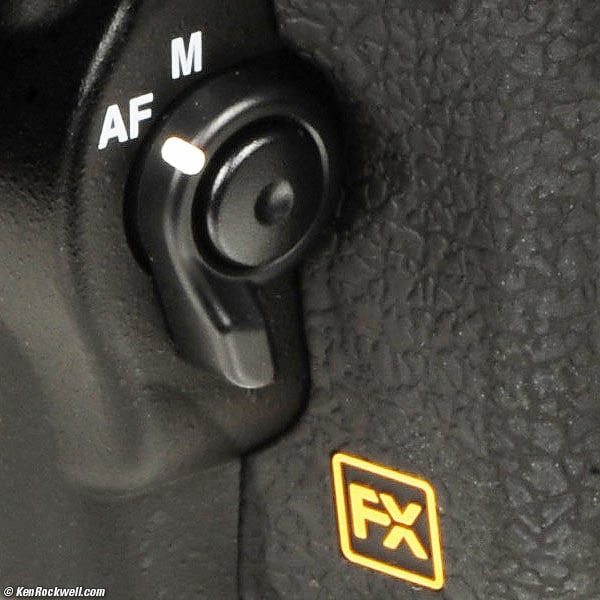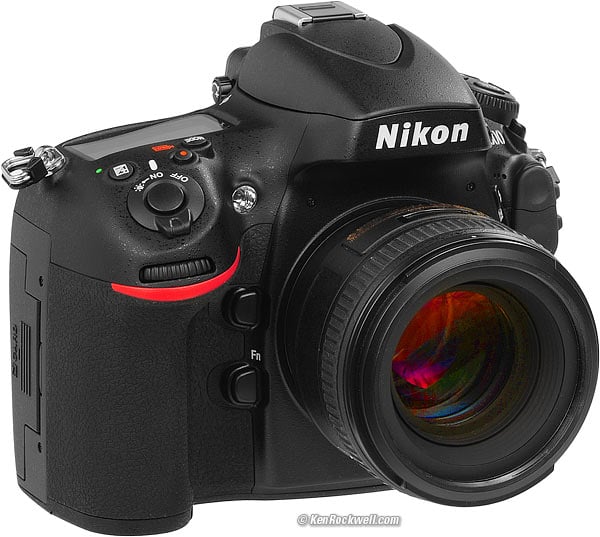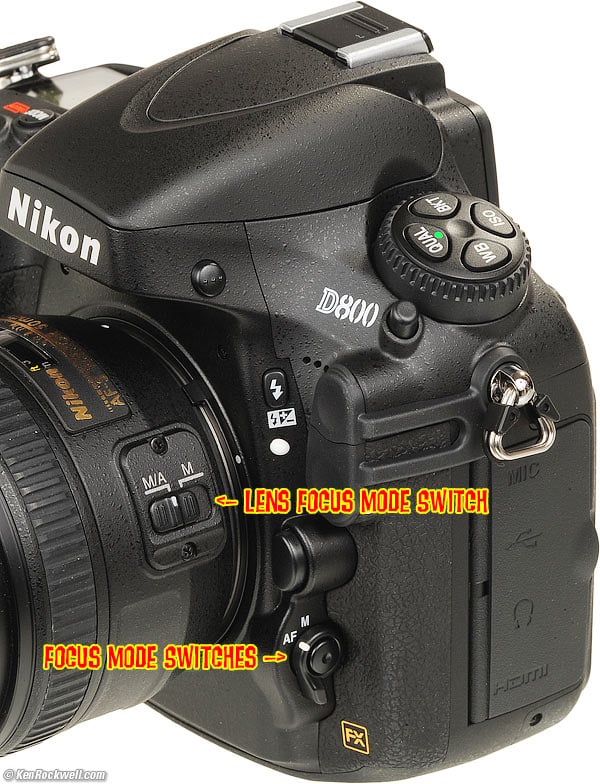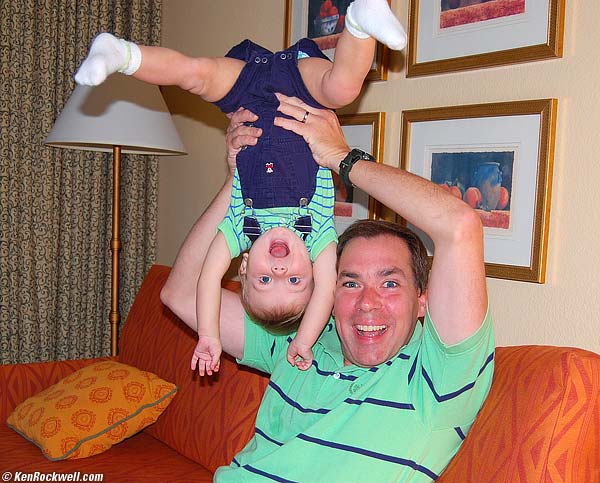Home Donate New Search Gallery Reviews How-To Books Links Workshops About Contact
Nikon D800 and D800E Autofocus Settings
© 2012 KenRockwell.com. All rights reserved.
Nikon D800 (about $3,000, 35.1 oz./994g with battery and CF card) and 50mm f/1.4 G. enlarge.
July 2012 D800 and D800E Review Nikon Reviews All Reviews
Nikon D800 and D800E User's Guide
This is specific to the Nikon D800 and D800E, whose AF systems are identical. See my Guide to Nikon AF Settings for guides to other cameras.
Here's how you set all this, what this all means, and why and when you might need to change what.
All these numerous options explained are mainly for shooting moving targets. For still subjects, simply using the center sensor is often still the best way to focus. Cameras have added all this AF system complexity to sell more cameras; you don't really need all this.
The D800 and D800E's AF system works in four dimensions at once. The first dimension obviously is distance. The second dimension is time, which we control with the AF-system mode settings. The two other dimensions are up-down and left-right, which are dealt with by having 51 different AF sensors spread all over the finder. We control how the D800 and D800E uses all its 51 AF sensors with the AF-Area mode controls.
First I'm going to show where to find the controls, then explain what control sets what and what each setting does, and finally I'll explain what settings to use for what sorts of pictures.
To get autofocus, set all the camera and lens switches to A (or M/A), otherwise you're in manual focus. I'll skip repeating this.
External Controls
There are only two external controls dedicated to setting the AF system: possibly a switch on the lens, and a lever and button on the camera body:
Nikon D800 and D800E AF Controls. bigger.
M/A - M Switch
Most newer AF-S lenses have an M/A - M switch as shown.
The M/A position means AUTOFOCUS and M is manual focus.
The reason autofocus is marked M/A is because you may grab the focus ring at any time for instant manual-focus override. It's a combination auto-manual setting.
The M position can be considered a way to lock-out the autofocus system, since manual focus always works.
M - A Switch
If the lens switch says M - A, one is manual, one is autofocus. Easy.
On some older lenses like the orignal 300mm f/4 AF, you also have to set the camera the same way, which is a pain.
No Lens Switch
Many original AF lenses have no switch.
No switch, no problem!

D800 & D800E Focus Mode Switches.
Camera's AF - M Lever
The AF - M lever is simple and obvious.
It selects auto or manual focus.
Camera's AF Mode Button
There is a tiny little button hidden in the center of the AF - M lever.
Pressing and holding this button while spinning dials is the key to all the autofocus settings.
I'll explain these various modes in the next section; here is how to set them.
The viewfinder displays what you're doing as you set it, so you can see all of this without taking your eye from the finder:
The AF system modes (single-locked or continous autofocius: AF-S or AF-C) are selected by holding the button and turing ther rear dial.
The AF-area modes (which sensors are used and how: one, all, some, 3D, etc.) are set by holding the button and spinnign the front dial.
Every Nikon AF camera has had these modes since 1988, even though they had only one AF sensor.
All Nikons use these same AF System modes. Innovations over the past decades have come from adding more AF sensors.
THe modes below work the same regardless of how and which sensors you use, which are explained later at AF-Area modes.
The AF system modes explained below control how and when the lens focuses in and out regardless of what AF sensors are selected, while the AF-Area modes explained later control which of the various sensors across the frame are selected and used.
AF-S (AutoFocus - Single)
AF-S means that the camera focuses once, and then locks. Use this for still subjects.
Hold the AF settings button and turn the rear dial to select this. You'll see "AFS" in the viewfinder, on the top LCD, and on the INFO Screen if active.
You point the camera at the subject, hold the shutter halfway until the OKdot in the finder lights, and then move the camera to recompose your photo while the focus stays locked.
Easy.
AF-C (AutoFocus - Continuous)
AF-C means that the camera focuses, and then keeps focusing as the subject moves in and out. This is used for sports and action.
Hold the AF settings button and turn the rear dial to select this. You'll see "AFC" in the viewfinder, on the top LCD, and on the INFO Screen if active.
AF-C works great, but on older cameras, only if your subject stayed in the middle of the frame, right under the single AF sensor.
Used with careful selection of many AF points under AF-Area modes explained next, the D800 and D800E can select different sensors to track motion all around the finder, while this AF-C mode lets the D800 and D800E keep fociussing.
AF-Area Modes (Auto, S, d9, d21, d51 and 3d)
AF-Area modes define which AF areas (sensors) are used by the D800 or D800E. Once selected, how these selected areas are used by the camera are set as AF System Modes above.
You may select any of these modes in AF-C, but in AF-S, only the S and Auto modes are available. These modes are:
AUTO select
Auto means the D800 and D800E picks which of its 51 sensors it will use, all by itself.
It works extremely well.
I use this mode all the time, and only use another setting if for some reason my camera isn't picking the AF areas I need all by itself.
I use AUTO select most of the time. THe D800 and D800E's AF systems are clairvouyant enough to find a subject's closest eye by magic, and are smart enough to identify the subject, even if there are nearer obstacles in the frame, most of the time. THis is one of the key advantages of the D800 and D800E over the Canon 5D MArk III, whose AF system isn't as smart. THe D800 and D800E's AF systems see in color and can recognize subjects, while Canon's can't. If you haven't trusted AUTO before, try it now; it's much more than a simple closest-sensor selector.
If AUTO isn't pciking what I need, I go directly to the 3D mode and select one point. In this 3D mode, once you assign an AF point to a target, it tracks and moves around the finder automatically as the target moves!
S: Single
If you want to use only one sensor, select S, or single.
Use the big rear thumb control to select which of the 51 sensors to use. Tap the center to go straight to the center sensor.
Once selected, the sensor will not move with this setting.
I'll use the center or other sensors when testing lenses, and that's about it. I prefer the AUTO and 3D modes.
d9: Dynamic 9
d9 is like the S selection, except that it uses a 3x3 sensor matrix centered around your selected sensor.
As a subject moves a little, the D800 and D800E will use its choice of any of these 9 sensors to arrive at the best focus — but only shows the first sensor you selected for the sake of your sanity.
I never use this. It is a good setting if you have a subject with limited motion, but I prefer the 3D setting for moving subjects.
d21: Dynamic 21
d21 is like the d9 selection, except that it uses a flock of 21 sensors centered around your selected sensor.
As a subject moves, the D800 and D800E will use its choice of any of these 21 sensors to arrive at the best focus — but only shows the first sensor you selected for the sake of your sanity.
I never use this. It is a good setting if you have a subject with moderate motion, but I prefer the 3D setting.
d51: Dynamic 51
d51 is like the d21 selection, except that it uses any of the sensors as it sees fit.
As a subject moves, the D800 and D800E will use its choice of any of the 51 sensors to arrive at the best focus — but only shows the first sensor you selected for the sake of your sanity.
This setting is best for unpredicably moving subjects.
I never use this.
3d: Three-Dimensional Color Tracking
3D allows the D800 or D800E to choose any sensor it likes as a subject moves all over.
Once you select 3d, select a sensor with the rear multi-control switch, and as soon as the D800 and D800E gets something in focus, the D800 and D800E will track that sucker all over the frame — and you'll see the sensor move, too!
In 3D mode, you don't even need to select or move the AF point. You may find it easier to use the center point, point the camera so the center point is on the target, and then move the camera and let it move the AF point for you, instead of selecting a different point with the thumb control.
The D800 and D800E is the smartest camera on earth for doing this, at least as I write this in July 2012. Once it gets focused, the D800 and D800E uses distance, motion and even color information to track your subject all over the frame, and keep the correct sensor selected and the focus locked to it like the bite of an angry pit bull. Once you select a sensor and the the D800 and D800E grabs focus, it's not letting go until you've got your shot.
Menu Controls
There are more controls in the menus, but once set once, you're good to go.
To set these, press:
MENU > CUSTOM SETTING MENU (pencil) > a Autofocus.
I explain them in great detail in the menus section of my Nikon D800 and D800E User's Guide.
THe main reason you ought to change one of these menu items is that the D800 and D800E default to taking a lot of out-of-focus pictures in the AF-C mode unless you change CSM a1 to ensure that it takes in-focus pictures — honest!
My Favorite Settings
Most of the Time
As I've said, I use AUTO AF-Area mode, and AF-S for stills and AF-C for people and action.
I use the 3D mode and select my own sensors to start if AUTO isn't cutting it.
Still Subjects
For still subjects, I use AF-S AF system mode, and leave it as above, or might pick just one sensor in S AF-Area mode.
Moving Subjects
For moving subjects, I leave it in AUTO AF-Area mode, and in AF-C AF system mode.
If and only if the D800 and D800E isn't picking the desired AF sensors all by itself, or isn't tracking movement, only then will I change the settings.
If the AF areas aren't tracking well, I'll select 3D AF-Area mode and select the starting AF areas manually.
Handing the D800 or D800E to a Non-Photographer
Ryan and Daddy, photo by mom (shot with Nikon D40, 2007).
The D800 and D800E makes great photos, even when used as a point-and-shoot.
When I hand my D800 and D800E to a non-photographer like my wife, I set it to AUTO AF-Area mode, and AF-C AF system mode.
More Information
KNOBS and BUTTONS
FRONT < < NEXT
MENUS
Help me help you top
I support my growing family through this website, as crazy as it might seem.
The biggest help is when you use any of these links when you get anything, regardless of the country in which you live. It costs you nothing, and is this site's, and thus my family's, biggest source of support. These places have the best prices and service, which is why I've used them since before this website existed. I recommend them all personally.
If you find this page as helpful as a book you might have had to buy or a workshop you may have had to take, feel free to help me continue helping everyone.
If you've gotten your gear through one of my links or helped otherwise, you're family. It's great people like you who allow me to keep adding to this site full-time. Thanks!
If you haven't helped yet, please do, and consider helping me with a gift of $5.00.
While free to read online, this page is formally registered and copyrighted, so it is unlawful to make copies, especially in the form of printouts for personal use or saving these pages or files. If you wish to make a printout for personal use, you are granted one-time permission to print from your browser (there is no PDF) only if you PayPal me $5.00 per printout, file save, or part thereof, unless of course you bought your D800 through one of my links. This is how I justify spending weeks away from my family writing and sharing all this for free online.
Thank you and thanks for your support!
Mr. & Mrs. Ken Rockwell, Ryan and Katie.
Home Donate New Search Gallery Reviews How-To Books Links Workshops About Contact



